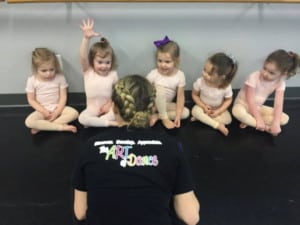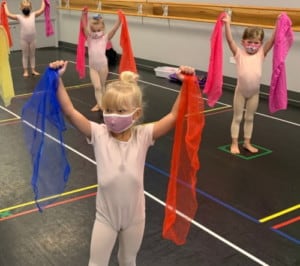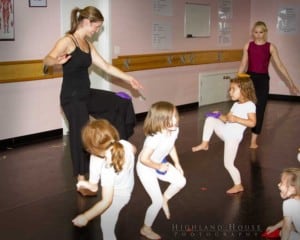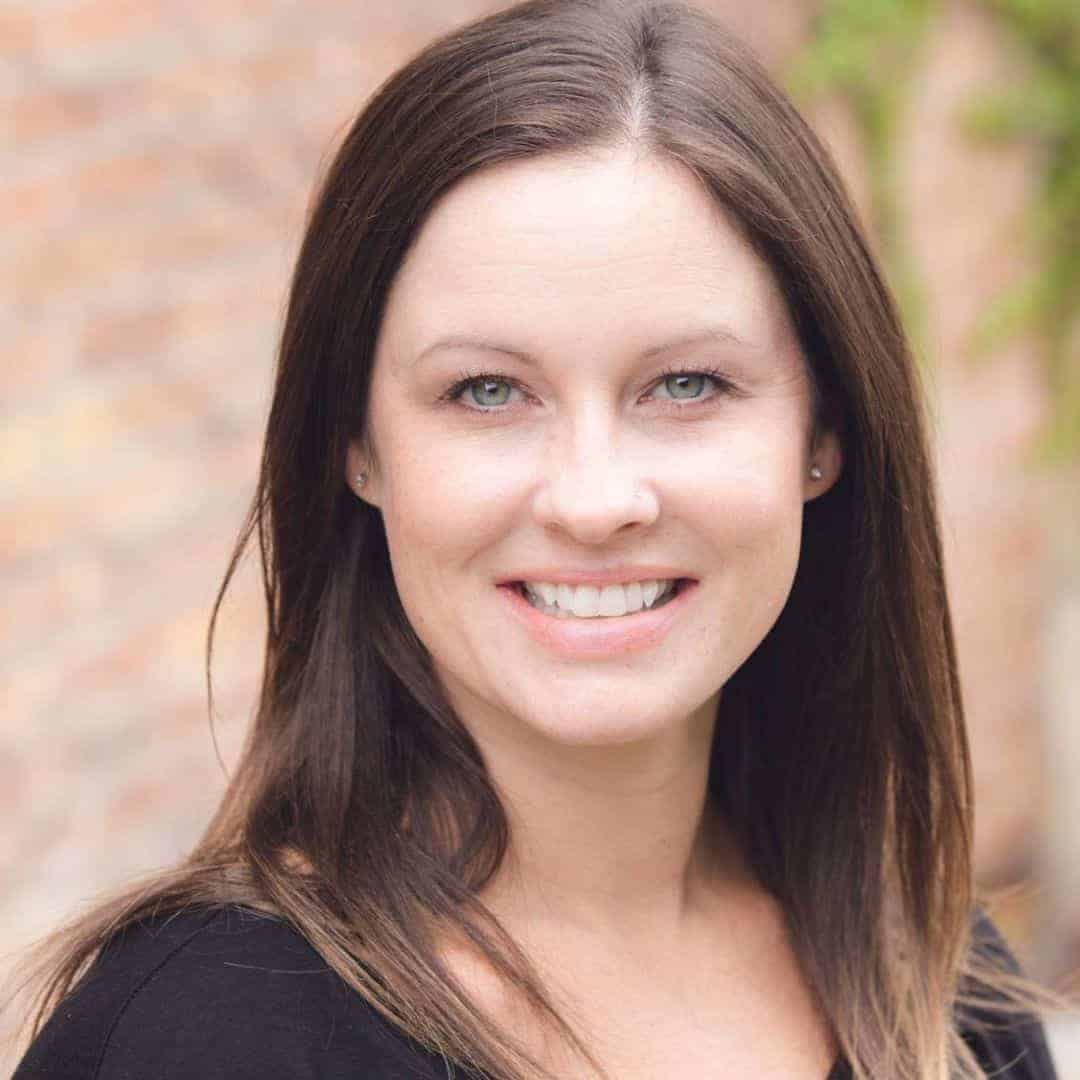Preschool Classroom Success: Transitions
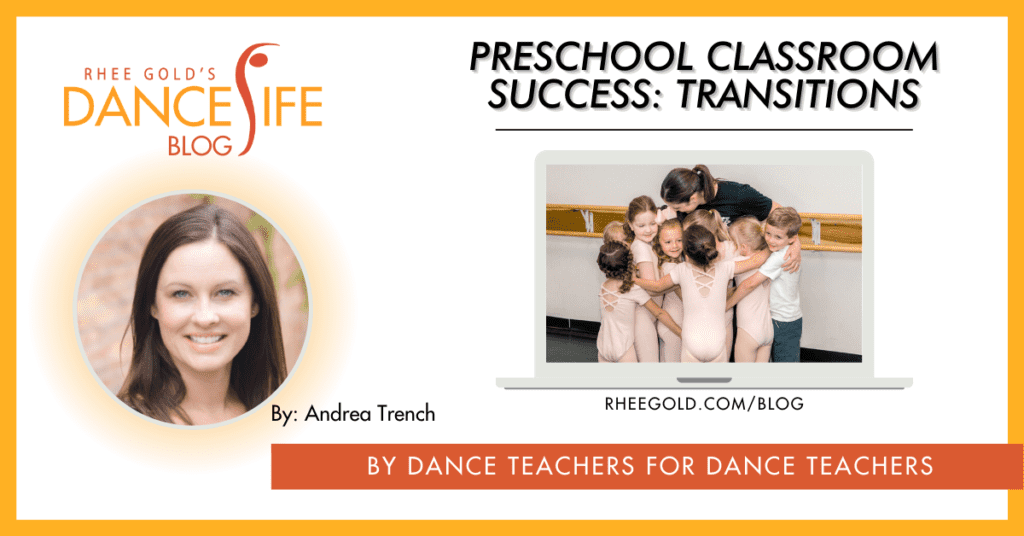
We spend so much time planning our class activities, choosing our music, and incorporating props to enrich our learning environment. During all of this planning, we may forget to also plan our activity transitions. When we neglect planning what will connect one activity to the other, we create an opportunity for off-track behavior.
Transitions are the systems we include to effectively manage our classroom, so learning can continue. This is why planning our transitions like we plan each and every other activity in our class is so important.
Today, I am sharing 3 times in our classes where a transition is necessary, examples of activities for each, and some extra tips for preschool classroom success!
Level Transitions
These transitions are used when going from standing to sitting or sitting to standing.
Standing to Sitting- Ready Position
At any time during class where my dancers are standing and I need them to sit, I’ll recite our “Ready Position” poem: “Have a seat on the floor, cross your legs, lock the door (pretend you are locking your mouth shut). Hands on knees. Eyes on Me. Ready position, let me see.” By the end of the poem, I have gathered any teaching materials or props that are needed and we are ready for the next activity to begin.
Sitting to Standing- Bridge and River
The “Bridge and River” transition gets us from a seated position to our standing ballet first position. Begin by crossing the right leg over the other with the right foot flat on the floor creating the “bridge”. The left leg is under the right leg creating the “river”. Use your hands to push up to the right foot and left knee before coming to stand in first position. As the dancers grow stronger, they will be able to move through this transition while keeping their arms in first position. We love transitions that can be incorporated into future choreography. Because they have been practicing this transition all season long, we can easily include it in our ballet choreography for recital.
Prop Transitions
We need two transitions for any activity that includes a prop: a distribution transition as well as a clean up transition.
Distribution- Free Choice with Instruction
It’s important that we offer our dancers free choice when it comes to choosing a prop as much as possible. When a child gets the option to choose, they have ownership of their decision. This builds independence, confidence, and responsibility because that is now “their” prop to take care of. When you follow the choice with an instruction, this gives them a job to do while they wait for everyone else to make their selections. Developing listening skills and keeping them busy with their job allows you the opportunity to make your own selection and quickly get the extra props out of sight before it’s time to begin the activity. Here are some examples...
“Dancers, choose two different colored scarves, one for each hand. Show me how you balance the scarves on your knee until our music begins.”
“Grab two shaker eggs and make sure they work as you go back to your spot.” After all dancers have returned to their spot, shake your eggs with your dancers then freeze. Continue a few times before beginning your activity.
Clean Up- Creative Prop Clean Up
Combine something that must be done with something fun. When it’s time to clean up our props, give the dancers a creative way to make this job exciting and engaging. Here are some examples…
“Dancers, put your scarf on your head and tiptoe it back to the bin.”
“Put your poly spot on your hand like a tray and march your poly spot to me. Continue marching back to your spot.”
Traveling Transitions
For any activity that moves from one spot to another such as circle to center work or center work to obstacle course, we need to have a transition in place.
Follow the Leader- Two Lines to a Circle
This transition is for when we are in two lines and we want to form a circle. Rather than just saying “make a circle”, I like to take this time for community building as well as navigating formation changes. This is another transition that can easily become part of their performance choreography.
Each dancer is on their tape mark in two lines. Stand next to a dancer and say, “I am turning my belly button and following Isabel. Isabel, who are you turning your belly button to?”. Continue through each dancer until everyone is facing in a circle. To the tune of “Farmer in the Dell” we tiptoe and sing, “we’re moving small and slow. We’re moving small and slow. This is the way we go in adagio. We’re moving small and fast. We’re moving small and fast. This is the way we go in allegro.” Now, we are in a circle and ready for the next activity.
Here are some extra tips for planning successful transitions:
“Show Me”
If you ask a dancer “Can you…” be prepared for them to say no. It’s best to not ask a dancer, can you stand up for me, please?” Rather, say “Show me how you stand tall while I put your beanbag on your head.” “Show me how you put your scarf away.” “Show me how you find your tape mark in 3,2,1…” This is a simple encouraging phrase that gets the job done.
Live Singing Piggyback Songs
Piggyback songs, like the one in our traveling transition above, are where you sing a familiar tune but you change the lyrics. The singing keeps their attention while the lyrics tell them what to do. Singing is the easiest and most powerful teaching strategy, especially when it comes to transitions.
Silent Tracks
Take a look at your lesson plan and decide where you need a transition, what the transition will be, and how long the transition will take. When it comes time to create your lesson playlist, add a silent track wherever a transition is listed. Silent tracks act as a buffer and allow your lesson plan to continuously flow without stopping and attending to music.
Here’s to preschool classroom success! Which tips and transitions will you be including in your lesson plans? Let me know below and let’s keep the conversation going.
Andrea Trench is dedicated to helping dance teachers create and deliver content that is research-based and developmentally appropriate for children under the age of 6. Her primary focus is classroom management, conceptual teaching, and foundational movement skill development in early childhood dance education. In addition, Andrea uses her 12 years of experience as a partner in a dance studio to inspire, equip, and empower educators.







